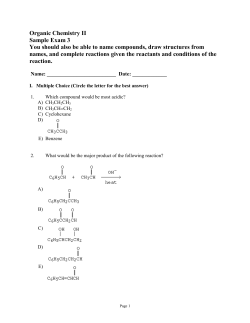
Sample Exam #4 a. monosaccharides.
Sample Exam #4 1. Starch, Glycogen, and Cellulose are all examples of a. monosaccharides. b. peptides. c. polysaccharides. d. lipids. e. disaccharides. 2. The molecule below could be described as a/an a. disaccharide CH2OH b. steroid c. aldopentose C=O d. ketopentose e. polysaccharide HO C H HO C H CH2OH 3. How many chiral carbons does the molecule in Question #2 have? a. 0 b. 1 c. 2 d. 3 e. 4 4. What type of lipid is the following compound? a. steroid b. hormone c. unsaturated fatty acid d. saturated fatty acid e. triglyceride 5. Which of the following describes a primary protein structure? a. protein structure maintained by disulfide linkages b. amino acid sequence maintained by peptide bonds c. protein chains maintained by interactions of peptide backbones d. arrangement of multiple protein subunits e. protein structure maintained through multiple hydrogen bonds 6. All 20 amino acids contain a. an ester and an amide group b. a ketone and an amine group c. an alcohol and a carboxylic acid group d. an amine and a carboxylic acid group e. all amino acids are distinctly different in their structure 7. Which of the following hold two strands of DNA in an a-helix? a. salt bridges b. disulfide linkages c. peptide bonds d. hydrogen bonds e. glycosidic linkages 8. The incomplete combustion of hydrocarbons produces ___, which has a high affinity to bond to iron in hemoglobin. a. CO2 b. SO2 c. CO d. O3 e. NO 9. Formaldehyde (CH2O) can undergo photodissociation in the atmosphere and contribute to smog. If the dissociation energy for this molecule is 357kJ/mol, then what is the minimum wavelength of light required to break this bond? CH2O(g) + light CHO(g) + H(g) a. 335 nm b. 3.35 x 10-4 m c. 278 nm d. 5.57 x 10-31 m e. none of the above 10. What substance acts as the reducing agent in the production of Fe metal? a. CaO b. O2 c. CO d. H2 e. both c and d 11. What is the coordination and oxidation numbers of Ni in the complex [Ni(en)2Cl2], respectively? a. 4 and +2 b. 6 and +2 c. 4 and 0 d. 6 and +4 e. 6 and 0 12. The correct formula for the complex named potassium tetrabromodicarbonylferrate(II) is a. K2 [Fe(CO)2Br4] b. K [Fe(CO)2Br4] c. K4 [Fe(CO)2Br4] d. K [Fe2(CO)2Br4] e. none of the above 13. Which of the following complexes could have cis/trans isomers? I. Pt(en)(CN)2 - (square planar) II. Co(en)2Br2 III. Ni(NH3)2Cl2 - (tetrahedral) IV. Cr(NH3)3Cl3 a. IV only b. II and IV c. I, II, and IV d. II only e. none of these 14. Which of the following would exhibit optical isomerism? a. Pt(NH3)2Cl2 – square planar b. Zn(NH3)2Cl2 – tetrahedral c. Cr(NH3)3Cl3 – octahedral d. Co(C2O4)2Cl2-3 – octahedral e. both c and d 15. Iron with a plus 3 oxidation state in solution appears yellow in color. This is because (color wheel on formula page) a. it absorbs only yellow wavelengths of light. b. it absorbs only violet wavelengths of light. c. it absorbs only red wavelengths of light. d. it absorbs only orange and green wavelengths of light. e. it reflects blue light. 16. The complex ion NiCl4-2 is tetrahedral. Based on CFT, how many unpaired electrons will it have? The electron configuration of (neutral) Ni is: [Ar] 4s2 3d8. a. 0 b. 1 c. 2 d. 3 e. 4 17. According to CFT, the complex [Ru(CN)6]-3 is known to have a large value of due to the strong field ligand making it low spin. How many unpaired electrons will it have? The electron configuration of (neutral) Ru is: [Kr] 5s1 4d7 a. 0 b. 1 c. 2 d. 4 e. 5 18. Which of the following complexes would be diamagnetic? a. FeF6-4 ; high spin b. Ti(en)3+2 c. Co(NH3)6+2 ; low spin d. Cu(en)2+2 ; square planar e. none of the above Answers: 1C, 2D, 3C, 4C, 5B, 6D, 7D, 8C, 9A, 10E, 11B, 12A, 13D, 14D, 15B, 16C, 17B, 18D
© Copyright 2025





















